Financial Management Report: Right Issue, Capital Budgeting Techniques
VerifiedAdded on 2023/01/13
|17
|3836
|56
Report
AI Summary
This financial management report provides a comprehensive analysis of key concepts. It begins with an introduction to financial management, emphasizing its importance in business strategy. The report then delves into a detailed examination of right issues, including calculations for share issuance, theoretical ex-right price, and earnings per share under different scenarios. The analysis extends to the advantages of scrip dividends for both companies and shareholders. The report also explores capital budgeting techniques, such as payback period, accounting rate of return, net present value (NPV), and internal rate of return (IRR), demonstrating their application in project feasibility assessment using a case study of a food manufacturer. Finally, the report presents a discussion of the advantages and disadvantages of various investment appraisal techniques, providing a well-rounded understanding of financial decision-making processes.
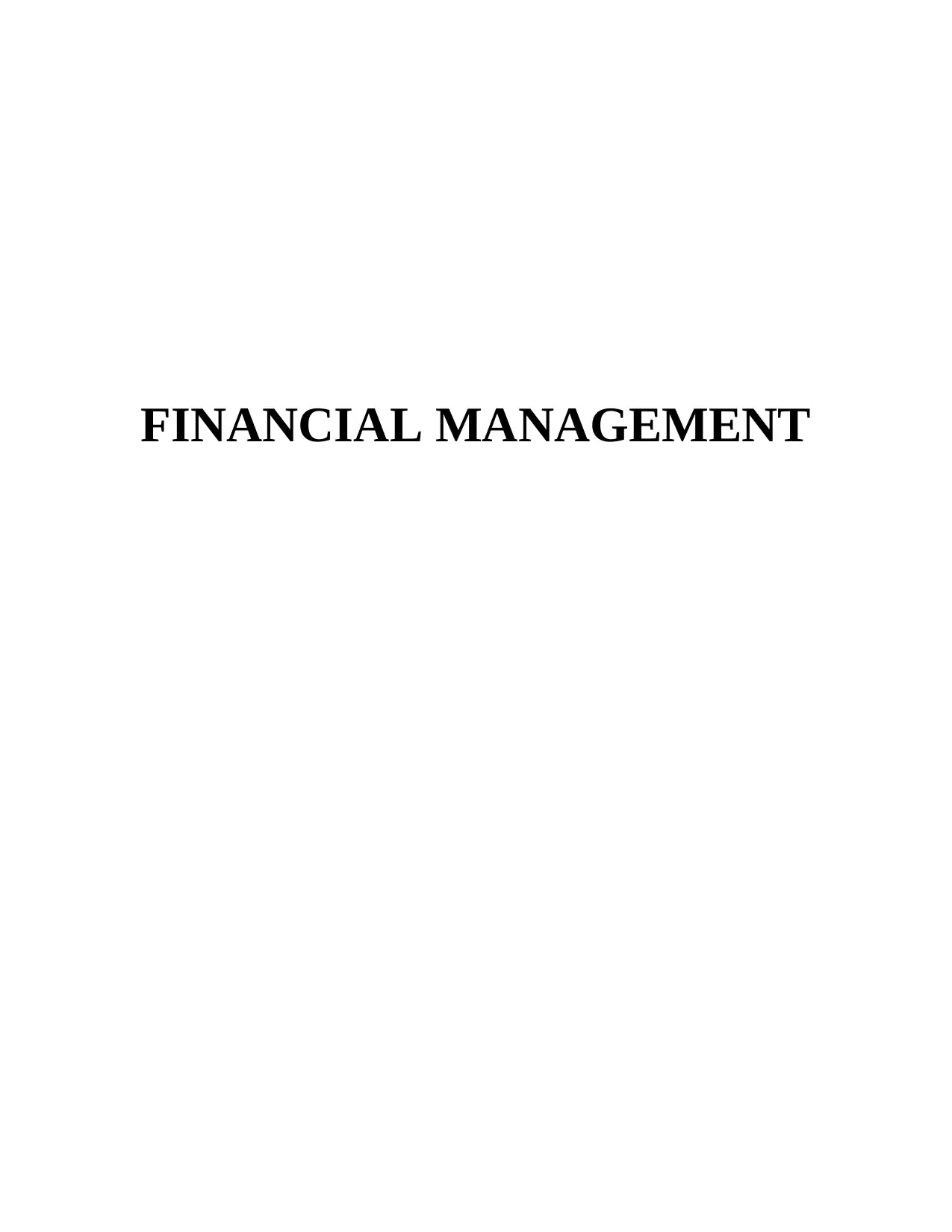
FINANCIAL MANAGEMENT
Paraphrase This Document
Need a fresh take? Get an instant paraphrase of this document with our AI Paraphraser
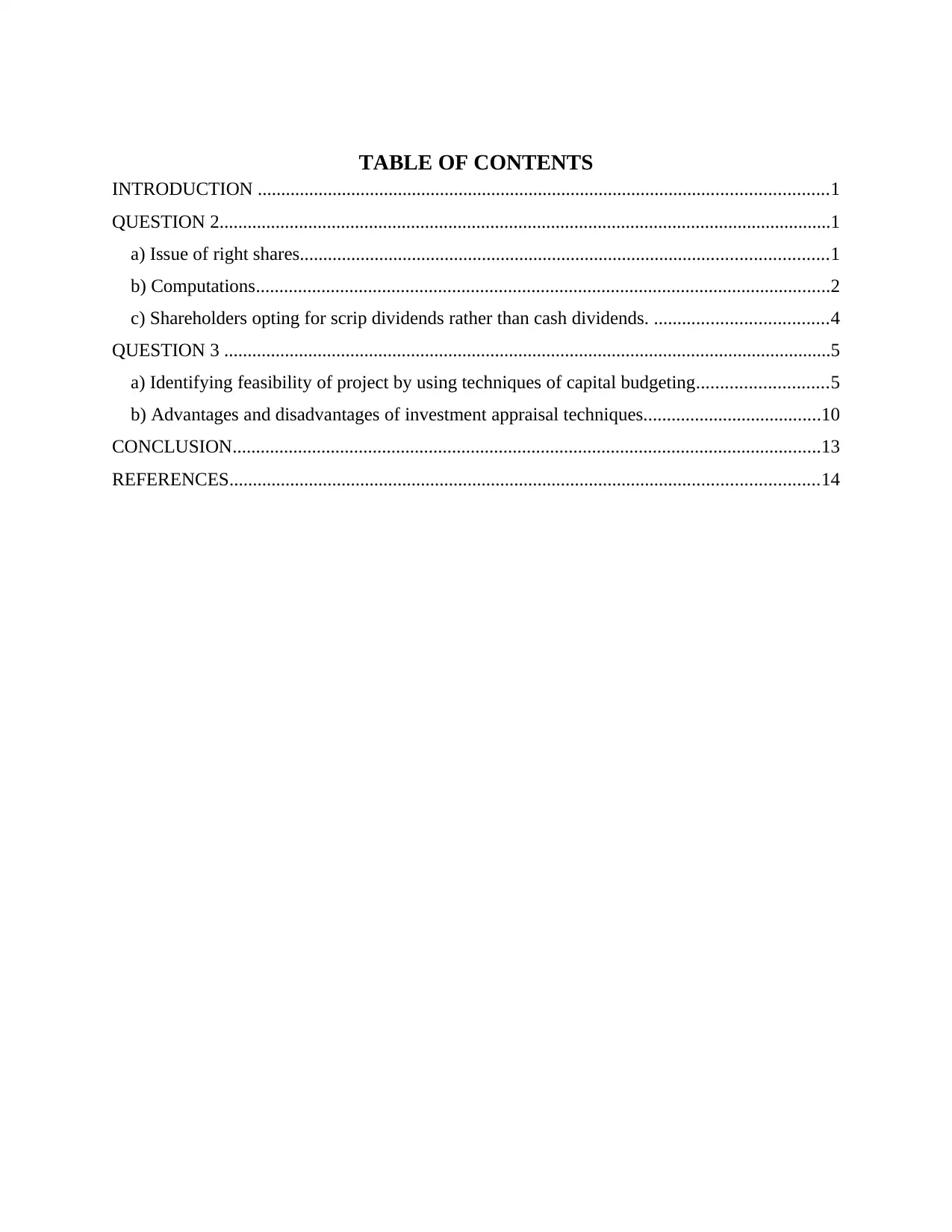
TABLE OF CONTENTS
INTRODUCTION ..........................................................................................................................1
QUESTION 2...................................................................................................................................1
a) Issue of right shares.................................................................................................................1
b) Computations...........................................................................................................................2
c) Shareholders opting for scrip dividends rather than cash dividends. .....................................4
QUESTION 3 ..................................................................................................................................5
a) Identifying feasibility of project by using techniques of capital budgeting............................5
b) Advantages and disadvantages of investment appraisal techniques......................................10
CONCLUSION..............................................................................................................................13
REFERENCES..............................................................................................................................14
INTRODUCTION ..........................................................................................................................1
QUESTION 2...................................................................................................................................1
a) Issue of right shares.................................................................................................................1
b) Computations...........................................................................................................................2
c) Shareholders opting for scrip dividends rather than cash dividends. .....................................4
QUESTION 3 ..................................................................................................................................5
a) Identifying feasibility of project by using techniques of capital budgeting............................5
b) Advantages and disadvantages of investment appraisal techniques......................................10
CONCLUSION..............................................................................................................................13
REFERENCES..............................................................................................................................14
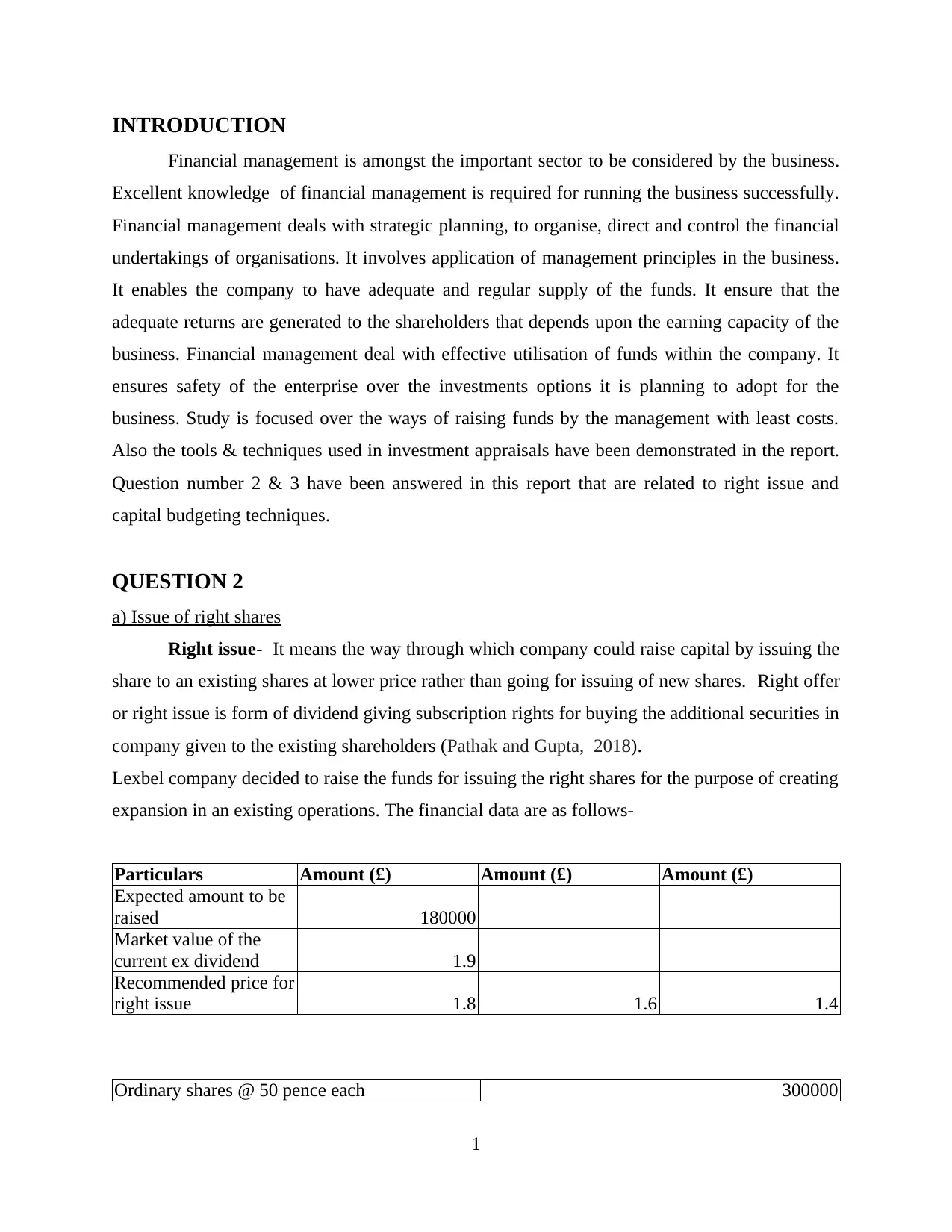
INTRODUCTION
Financial management is amongst the important sector to be considered by the business.
Excellent knowledge of financial management is required for running the business successfully.
Financial management deals with strategic planning, to organise, direct and control the financial
undertakings of organisations. It involves application of management principles in the business.
It enables the company to have adequate and regular supply of the funds. It ensure that the
adequate returns are generated to the shareholders that depends upon the earning capacity of the
business. Financial management deal with effective utilisation of funds within the company. It
ensures safety of the enterprise over the investments options it is planning to adopt for the
business. Study is focused over the ways of raising funds by the management with least costs.
Also the tools & techniques used in investment appraisals have been demonstrated in the report.
Question number 2 & 3 have been answered in this report that are related to right issue and
capital budgeting techniques.
QUESTION 2
a) Issue of right shares
Right issue- It means the way through which company could raise capital by issuing the
share to an existing shares at lower price rather than going for issuing of new shares. Right offer
or right issue is form of dividend giving subscription rights for buying the additional securities in
company given to the existing shareholders (Pathak and Gupta, 2018).
Lexbel company decided to raise the funds for issuing the right shares for the purpose of creating
expansion in an existing operations. The financial data are as follows-
Particulars Amount (£) Amount (£) Amount (£)
Expected amount to be
raised 180000
Market value of the
current ex dividend 1.9
Recommended price for
right issue 1.8 1.6 1.4
Ordinary shares @ 50 pence each 300000
1
Financial management is amongst the important sector to be considered by the business.
Excellent knowledge of financial management is required for running the business successfully.
Financial management deals with strategic planning, to organise, direct and control the financial
undertakings of organisations. It involves application of management principles in the business.
It enables the company to have adequate and regular supply of the funds. It ensure that the
adequate returns are generated to the shareholders that depends upon the earning capacity of the
business. Financial management deal with effective utilisation of funds within the company. It
ensures safety of the enterprise over the investments options it is planning to adopt for the
business. Study is focused over the ways of raising funds by the management with least costs.
Also the tools & techniques used in investment appraisals have been demonstrated in the report.
Question number 2 & 3 have been answered in this report that are related to right issue and
capital budgeting techniques.
QUESTION 2
a) Issue of right shares
Right issue- It means the way through which company could raise capital by issuing the
share to an existing shares at lower price rather than going for issuing of new shares. Right offer
or right issue is form of dividend giving subscription rights for buying the additional securities in
company given to the existing shareholders (Pathak and Gupta, 2018).
Lexbel company decided to raise the funds for issuing the right shares for the purpose of creating
expansion in an existing operations. The financial data are as follows-
Particulars Amount (£) Amount (£) Amount (£)
Expected amount to be
raised 180000
Market value of the
current ex dividend 1.9
Recommended price for
right issue 1.8 1.6 1.4
Ordinary shares @ 50 pence each 300000
1
⊘ This is a preview!⊘
Do you want full access?
Subscribe today to unlock all pages.

Trusted by 1+ million students worldwide
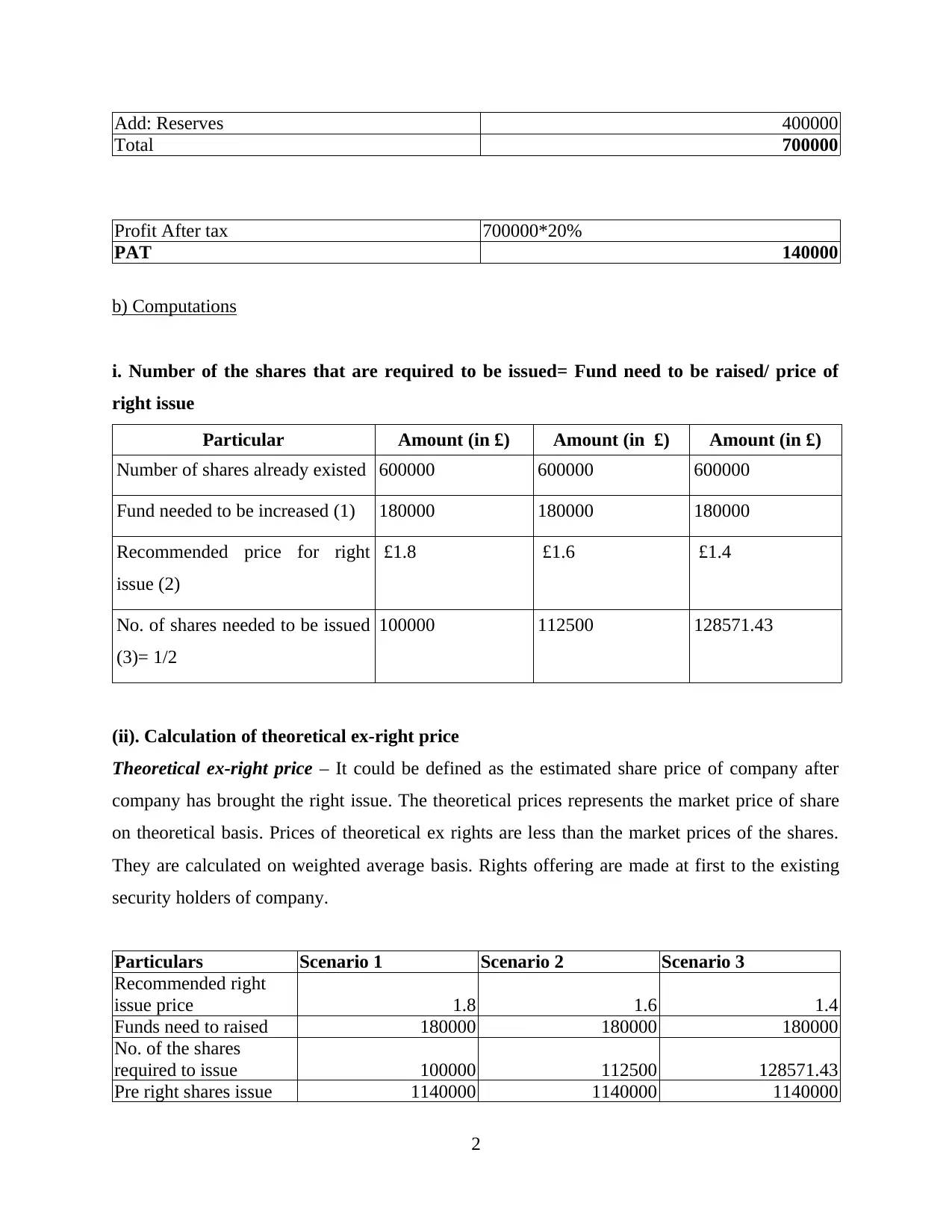
Add: Reserves 400000
Total 700000
Profit After tax 700000*20%
PAT 140000
b) Computations
i. Number of the shares that are required to be issued= Fund need to be raised/ price of
right issue
Particular Amount (in £) Amount (in £) Amount (in £)
Number of shares already existed 600000 600000 600000
Fund needed to be increased (1) 180000 180000 180000
Recommended price for right
issue (2)
£1.8 £1.6 £1.4
No. of shares needed to be issued
(3)= 1/2
100000 112500 128571.43
(ii). Calculation of theoretical ex-right price
Theoretical ex-right price – It could be defined as the estimated share price of company after
company has brought the right issue. The theoretical prices represents the market price of share
on theoretical basis. Prices of theoretical ex rights are less than the market prices of the shares.
They are calculated on weighted average basis. Rights offering are made at first to the existing
security holders of company.
Particulars Scenario 1 Scenario 2 Scenario 3
Recommended right
issue price 1.8 1.6 1.4
Funds need to raised 180000 180000 180000
No. of the shares
required to issue 100000 112500 128571.43
Pre right shares issue 1140000 1140000 1140000
2
Total 700000
Profit After tax 700000*20%
PAT 140000
b) Computations
i. Number of the shares that are required to be issued= Fund need to be raised/ price of
right issue
Particular Amount (in £) Amount (in £) Amount (in £)
Number of shares already existed 600000 600000 600000
Fund needed to be increased (1) 180000 180000 180000
Recommended price for right
issue (2)
£1.8 £1.6 £1.4
No. of shares needed to be issued
(3)= 1/2
100000 112500 128571.43
(ii). Calculation of theoretical ex-right price
Theoretical ex-right price – It could be defined as the estimated share price of company after
company has brought the right issue. The theoretical prices represents the market price of share
on theoretical basis. Prices of theoretical ex rights are less than the market prices of the shares.
They are calculated on weighted average basis. Rights offering are made at first to the existing
security holders of company.
Particulars Scenario 1 Scenario 2 Scenario 3
Recommended right
issue price 1.8 1.6 1.4
Funds need to raised 180000 180000 180000
No. of the shares
required to issue 100000 112500 128571.43
Pre right shares issue 1140000 1140000 1140000
2
Paraphrase This Document
Need a fresh take? Get an instant paraphrase of this document with our AI Paraphraser
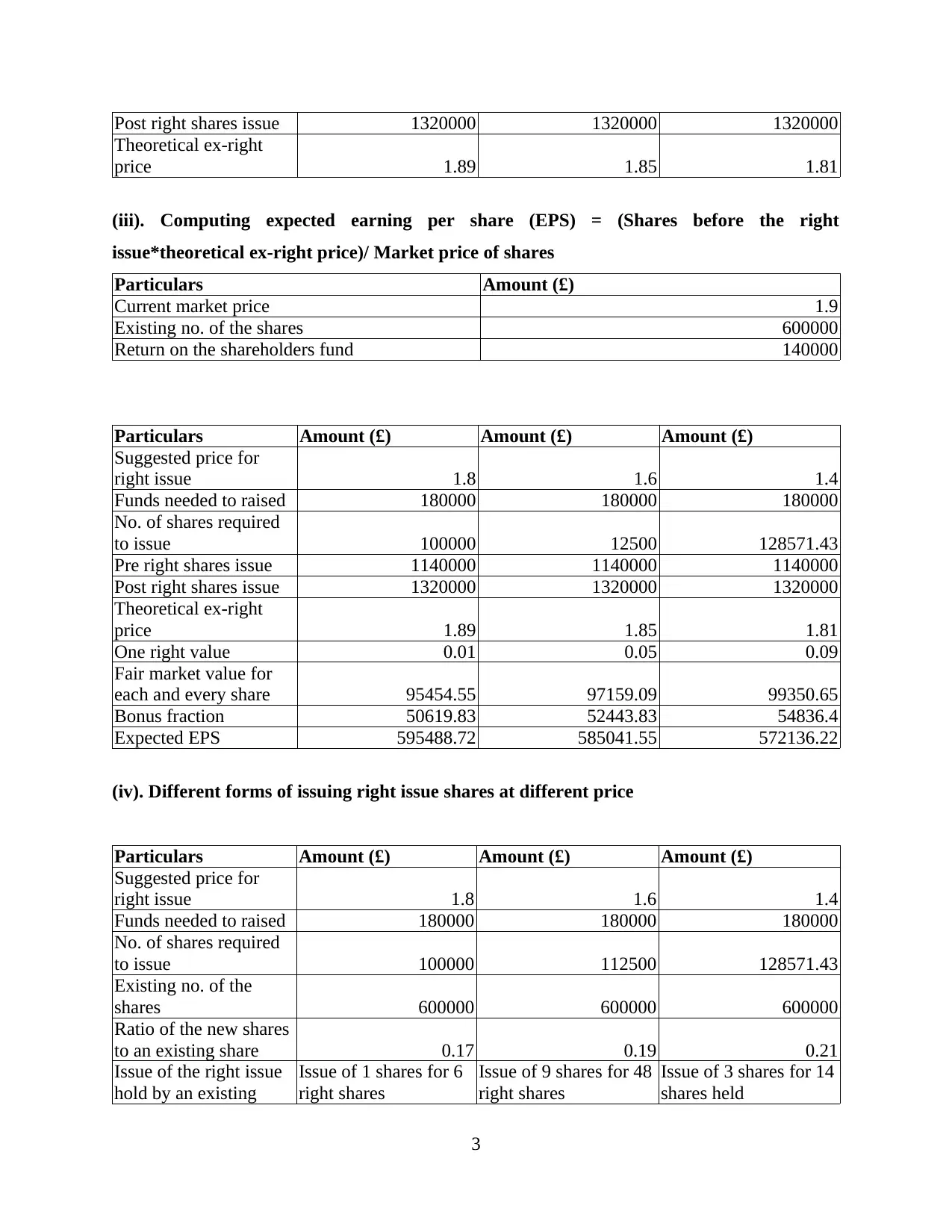
Post right shares issue 1320000 1320000 1320000
Theoretical ex-right
price 1.89 1.85 1.81
(iii). Computing expected earning per share (EPS) = (Shares before the right
issue*theoretical ex-right price)/ Market price of shares
Particulars Amount (£)
Current market price 1.9
Existing no. of the shares 600000
Return on the shareholders fund 140000
Particulars Amount (£) Amount (£) Amount (£)
Suggested price for
right issue 1.8 1.6 1.4
Funds needed to raised 180000 180000 180000
No. of shares required
to issue 100000 12500 128571.43
Pre right shares issue 1140000 1140000 1140000
Post right shares issue 1320000 1320000 1320000
Theoretical ex-right
price 1.89 1.85 1.81
One right value 0.01 0.05 0.09
Fair market value for
each and every share 95454.55 97159.09 99350.65
Bonus fraction 50619.83 52443.83 54836.4
Expected EPS 595488.72 585041.55 572136.22
(iv). Different forms of issuing right issue shares at different price
Particulars Amount (£) Amount (£) Amount (£)
Suggested price for
right issue 1.8 1.6 1.4
Funds needed to raised 180000 180000 180000
No. of shares required
to issue 100000 112500 128571.43
Existing no. of the
shares 600000 600000 600000
Ratio of the new shares
to an existing share 0.17 0.19 0.21
Issue of the right issue
hold by an existing
Issue of 1 shares for 6
right shares
Issue of 9 shares for 48
right shares
Issue of 3 shares for 14
shares held
3
Theoretical ex-right
price 1.89 1.85 1.81
(iii). Computing expected earning per share (EPS) = (Shares before the right
issue*theoretical ex-right price)/ Market price of shares
Particulars Amount (£)
Current market price 1.9
Existing no. of the shares 600000
Return on the shareholders fund 140000
Particulars Amount (£) Amount (£) Amount (£)
Suggested price for
right issue 1.8 1.6 1.4
Funds needed to raised 180000 180000 180000
No. of shares required
to issue 100000 12500 128571.43
Pre right shares issue 1140000 1140000 1140000
Post right shares issue 1320000 1320000 1320000
Theoretical ex-right
price 1.89 1.85 1.81
One right value 0.01 0.05 0.09
Fair market value for
each and every share 95454.55 97159.09 99350.65
Bonus fraction 50619.83 52443.83 54836.4
Expected EPS 595488.72 585041.55 572136.22
(iv). Different forms of issuing right issue shares at different price
Particulars Amount (£) Amount (£) Amount (£)
Suggested price for
right issue 1.8 1.6 1.4
Funds needed to raised 180000 180000 180000
No. of shares required
to issue 100000 112500 128571.43
Existing no. of the
shares 600000 600000 600000
Ratio of the new shares
to an existing share 0.17 0.19 0.21
Issue of the right issue
hold by an existing
Issue of 1 shares for 6
right shares
Issue of 9 shares for 48
right shares
Issue of 3 shares for 14
shares held
3
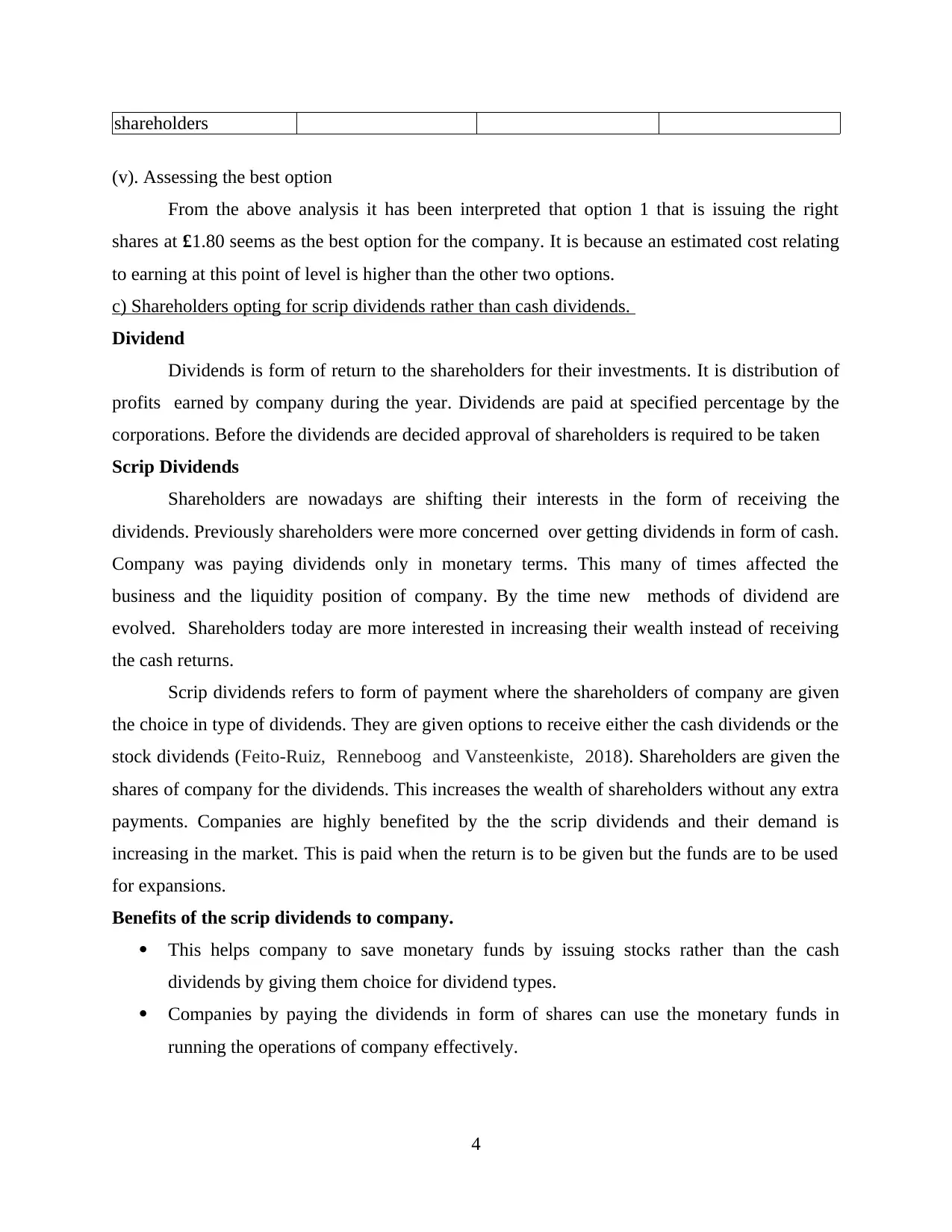
shareholders
(v). Assessing the best option
From the above analysis it has been interpreted that option 1 that is issuing the right
shares at £1.80 seems as the best option for the company. It is because an estimated cost relating
to earning at this point of level is higher than the other two options.
c) Shareholders opting for scrip dividends rather than cash dividends.
Dividend
Dividends is form of return to the shareholders for their investments. It is distribution of
profits earned by company during the year. Dividends are paid at specified percentage by the
corporations. Before the dividends are decided approval of shareholders is required to be taken
Scrip Dividends
Shareholders are nowadays are shifting their interests in the form of receiving the
dividends. Previously shareholders were more concerned over getting dividends in form of cash.
Company was paying dividends only in monetary terms. This many of times affected the
business and the liquidity position of company. By the time new methods of dividend are
evolved. Shareholders today are more interested in increasing their wealth instead of receiving
the cash returns.
Scrip dividends refers to form of payment where the shareholders of company are given
the choice in type of dividends. They are given options to receive either the cash dividends or the
stock dividends (Feito-Ruiz, Renneboog and Vansteenkiste, 2018). Shareholders are given the
shares of company for the dividends. This increases the wealth of shareholders without any extra
payments. Companies are highly benefited by the the scrip dividends and their demand is
increasing in the market. This is paid when the return is to be given but the funds are to be used
for expansions.
Benefits of the scrip dividends to company.
This helps company to save monetary funds by issuing stocks rather than the cash
dividends by giving them choice for dividend types.
Companies by paying the dividends in form of shares can use the monetary funds in
running the operations of company effectively.
4
(v). Assessing the best option
From the above analysis it has been interpreted that option 1 that is issuing the right
shares at £1.80 seems as the best option for the company. It is because an estimated cost relating
to earning at this point of level is higher than the other two options.
c) Shareholders opting for scrip dividends rather than cash dividends.
Dividend
Dividends is form of return to the shareholders for their investments. It is distribution of
profits earned by company during the year. Dividends are paid at specified percentage by the
corporations. Before the dividends are decided approval of shareholders is required to be taken
Scrip Dividends
Shareholders are nowadays are shifting their interests in the form of receiving the
dividends. Previously shareholders were more concerned over getting dividends in form of cash.
Company was paying dividends only in monetary terms. This many of times affected the
business and the liquidity position of company. By the time new methods of dividend are
evolved. Shareholders today are more interested in increasing their wealth instead of receiving
the cash returns.
Scrip dividends refers to form of payment where the shareholders of company are given
the choice in type of dividends. They are given options to receive either the cash dividends or the
stock dividends (Feito-Ruiz, Renneboog and Vansteenkiste, 2018). Shareholders are given the
shares of company for the dividends. This increases the wealth of shareholders without any extra
payments. Companies are highly benefited by the the scrip dividends and their demand is
increasing in the market. This is paid when the return is to be given but the funds are to be used
for expansions.
Benefits of the scrip dividends to company.
This helps company to save monetary funds by issuing stocks rather than the cash
dividends by giving them choice for dividend types.
Companies by paying the dividends in form of shares can use the monetary funds in
running the operations of company effectively.
4
⊘ This is a preview!⊘
Do you want full access?
Subscribe today to unlock all pages.

Trusted by 1+ million students worldwide
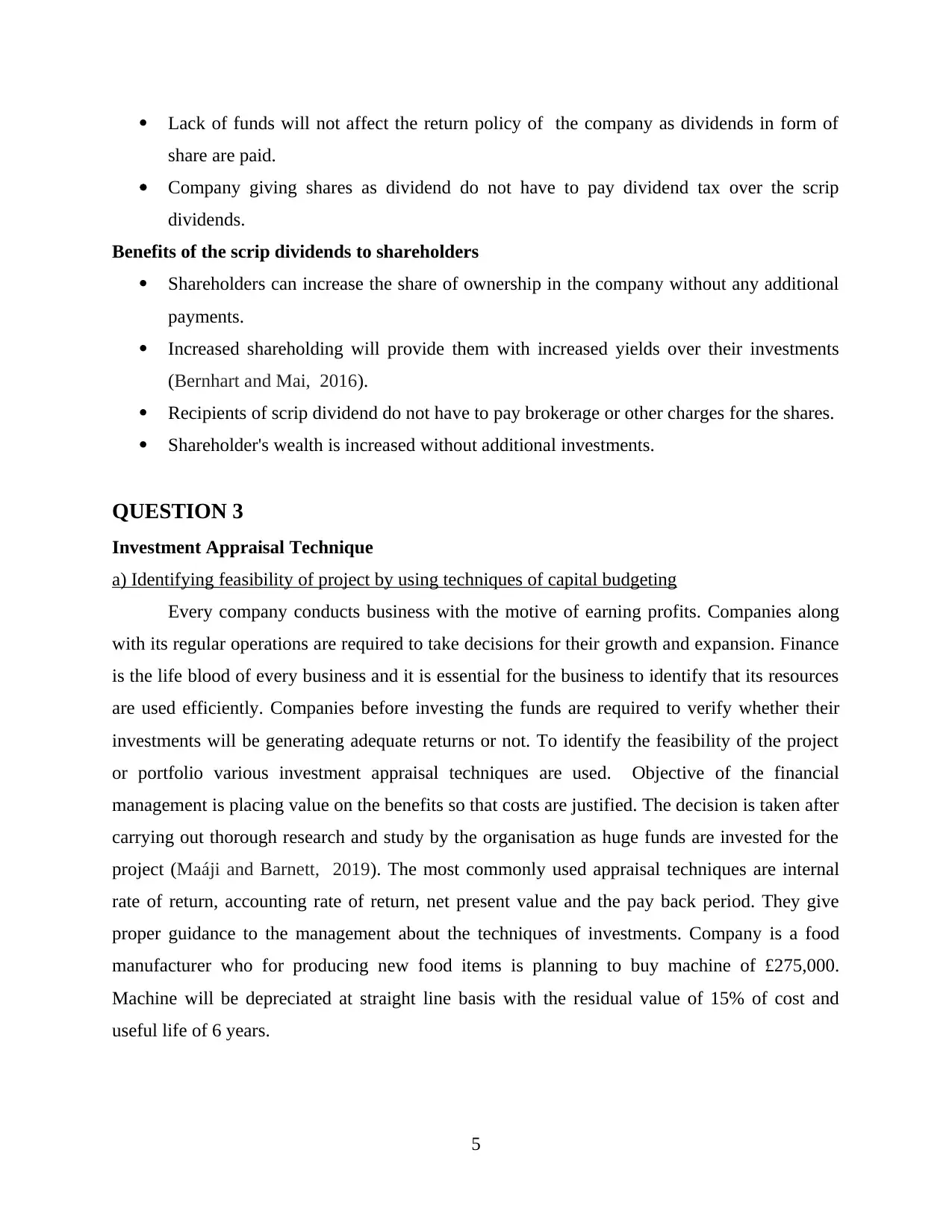
Lack of funds will not affect the return policy of the company as dividends in form of
share are paid.
Company giving shares as dividend do not have to pay dividend tax over the scrip
dividends.
Benefits of the scrip dividends to shareholders
Shareholders can increase the share of ownership in the company without any additional
payments.
Increased shareholding will provide them with increased yields over their investments
(Bernhart and Mai, 2016).
Recipients of scrip dividend do not have to pay brokerage or other charges for the shares.
Shareholder's wealth is increased without additional investments.
QUESTION 3
Investment Appraisal Technique
a) Identifying feasibility of project by using techniques of capital budgeting
Every company conducts business with the motive of earning profits. Companies along
with its regular operations are required to take decisions for their growth and expansion. Finance
is the life blood of every business and it is essential for the business to identify that its resources
are used efficiently. Companies before investing the funds are required to verify whether their
investments will be generating adequate returns or not. To identify the feasibility of the project
or portfolio various investment appraisal techniques are used. Objective of the financial
management is placing value on the benefits so that costs are justified. The decision is taken after
carrying out thorough research and study by the organisation as huge funds are invested for the
project (Maáji and Barnett, 2019). The most commonly used appraisal techniques are internal
rate of return, accounting rate of return, net present value and the pay back period. They give
proper guidance to the management about the techniques of investments. Company is a food
manufacturer who for producing new food items is planning to buy machine of £275,000.
Machine will be depreciated at straight line basis with the residual value of 15% of cost and
useful life of 6 years.
5
share are paid.
Company giving shares as dividend do not have to pay dividend tax over the scrip
dividends.
Benefits of the scrip dividends to shareholders
Shareholders can increase the share of ownership in the company without any additional
payments.
Increased shareholding will provide them with increased yields over their investments
(Bernhart and Mai, 2016).
Recipients of scrip dividend do not have to pay brokerage or other charges for the shares.
Shareholder's wealth is increased without additional investments.
QUESTION 3
Investment Appraisal Technique
a) Identifying feasibility of project by using techniques of capital budgeting
Every company conducts business with the motive of earning profits. Companies along
with its regular operations are required to take decisions for their growth and expansion. Finance
is the life blood of every business and it is essential for the business to identify that its resources
are used efficiently. Companies before investing the funds are required to verify whether their
investments will be generating adequate returns or not. To identify the feasibility of the project
or portfolio various investment appraisal techniques are used. Objective of the financial
management is placing value on the benefits so that costs are justified. The decision is taken after
carrying out thorough research and study by the organisation as huge funds are invested for the
project (Maáji and Barnett, 2019). The most commonly used appraisal techniques are internal
rate of return, accounting rate of return, net present value and the pay back period. They give
proper guidance to the management about the techniques of investments. Company is a food
manufacturer who for producing new food items is planning to buy machine of £275,000.
Machine will be depreciated at straight line basis with the residual value of 15% of cost and
useful life of 6 years.
5
Paraphrase This Document
Need a fresh take? Get an instant paraphrase of this document with our AI Paraphraser
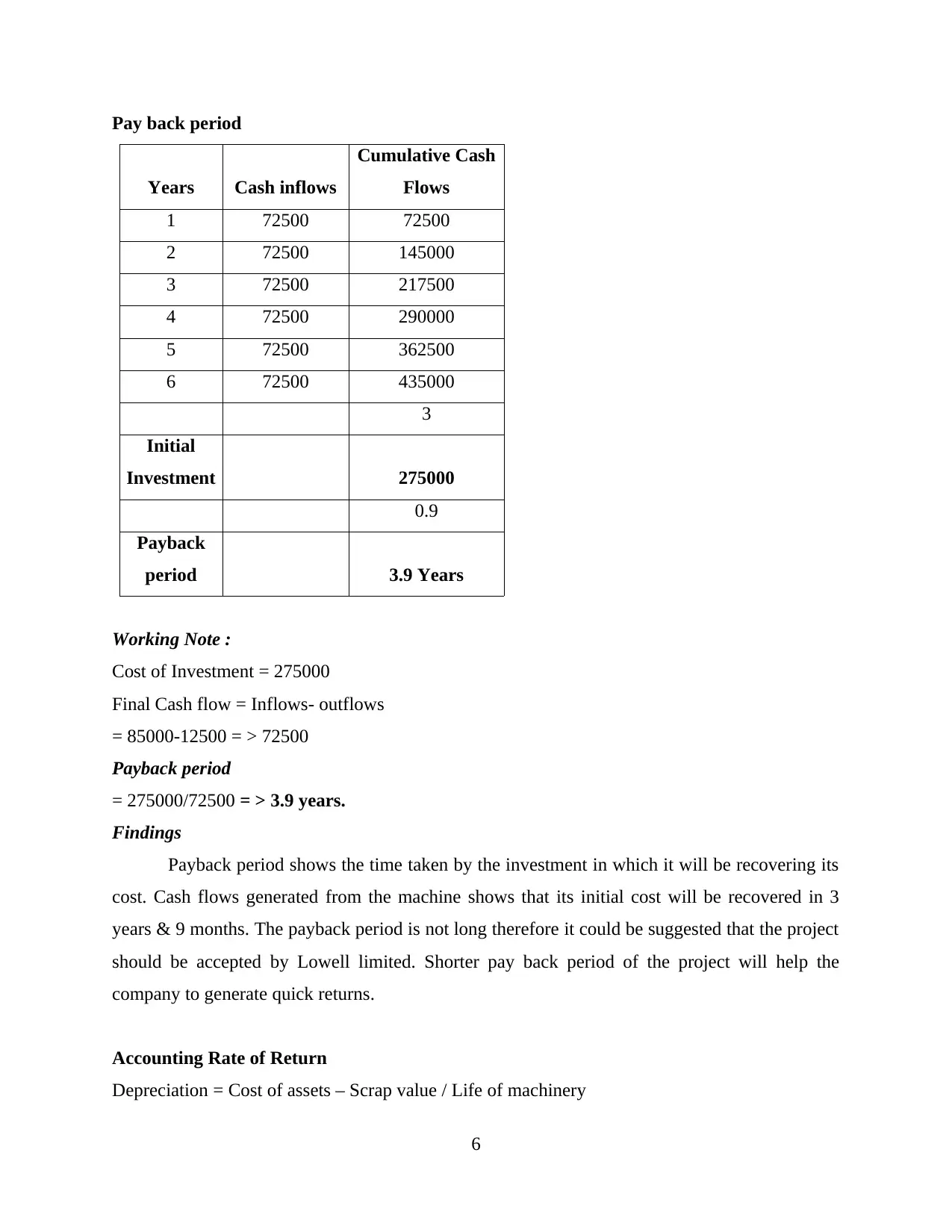
Pay back period
Years Cash inflows
Cumulative Cash
Flows
1 72500 72500
2 72500 145000
3 72500 217500
4 72500 290000
5 72500 362500
6 72500 435000
3
Initial
Investment 275000
0.9
Payback
period 3.9 Years
Working Note :
Cost of Investment = 275000
Final Cash flow = Inflows- outflows
= 85000-12500 = > 72500
Payback period
= 275000/72500 = > 3.9 years.
Findings
Payback period shows the time taken by the investment in which it will be recovering its
cost. Cash flows generated from the machine shows that its initial cost will be recovered in 3
years & 9 months. The payback period is not long therefore it could be suggested that the project
should be accepted by Lowell limited. Shorter pay back period of the project will help the
company to generate quick returns.
Accounting Rate of Return
Depreciation = Cost of assets – Scrap value / Life of machinery
6
Years Cash inflows
Cumulative Cash
Flows
1 72500 72500
2 72500 145000
3 72500 217500
4 72500 290000
5 72500 362500
6 72500 435000
3
Initial
Investment 275000
0.9
Payback
period 3.9 Years
Working Note :
Cost of Investment = 275000
Final Cash flow = Inflows- outflows
= 85000-12500 = > 72500
Payback period
= 275000/72500 = > 3.9 years.
Findings
Payback period shows the time taken by the investment in which it will be recovering its
cost. Cash flows generated from the machine shows that its initial cost will be recovered in 3
years & 9 months. The payback period is not long therefore it could be suggested that the project
should be accepted by Lowell limited. Shorter pay back period of the project will help the
company to generate quick returns.
Accounting Rate of Return
Depreciation = Cost of assets – Scrap value / Life of machinery
6
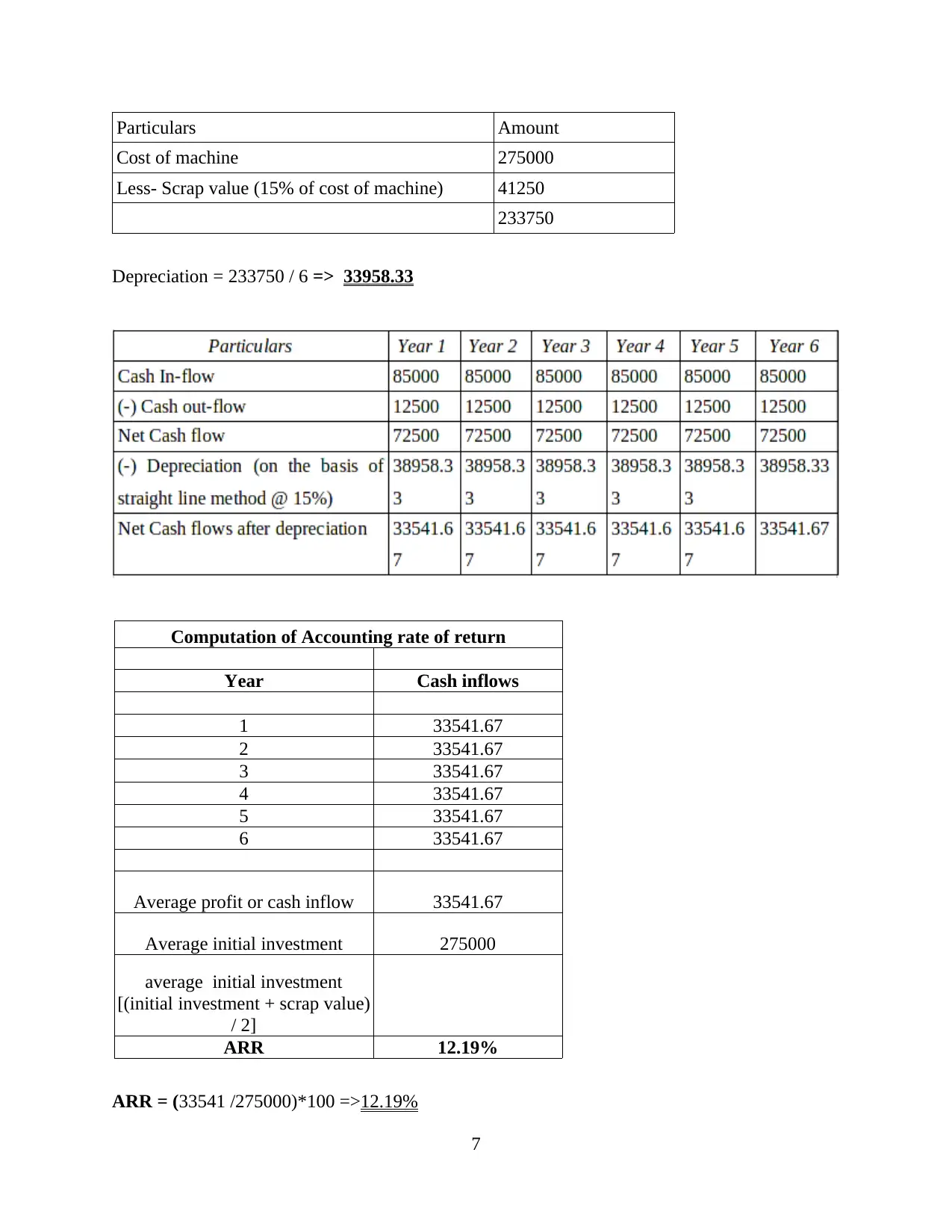
Particulars Amount
Cost of machine 275000
Less- Scrap value (15% of cost of machine) 41250
233750
Depreciation = 233750 / 6 => 33958.33
Computation of Accounting rate of return
Year Cash inflows
1 33541.67
2 33541.67
3 33541.67
4 33541.67
5 33541.67
6 33541.67
Average profit or cash inflow 33541.67
Average initial investment 275000
average initial investment
[(initial investment + scrap value)
/ 2]
ARR 12.19%
ARR = (33541 /275000)*100 =>12.19%
7
Cost of machine 275000
Less- Scrap value (15% of cost of machine) 41250
233750
Depreciation = 233750 / 6 => 33958.33
Computation of Accounting rate of return
Year Cash inflows
1 33541.67
2 33541.67
3 33541.67
4 33541.67
5 33541.67
6 33541.67
Average profit or cash inflow 33541.67
Average initial investment 275000
average initial investment
[(initial investment + scrap value)
/ 2]
ARR 12.19%
ARR = (33541 /275000)*100 =>12.19%
7
⊘ This is a preview!⊘
Do you want full access?
Subscribe today to unlock all pages.

Trusted by 1+ million students worldwide
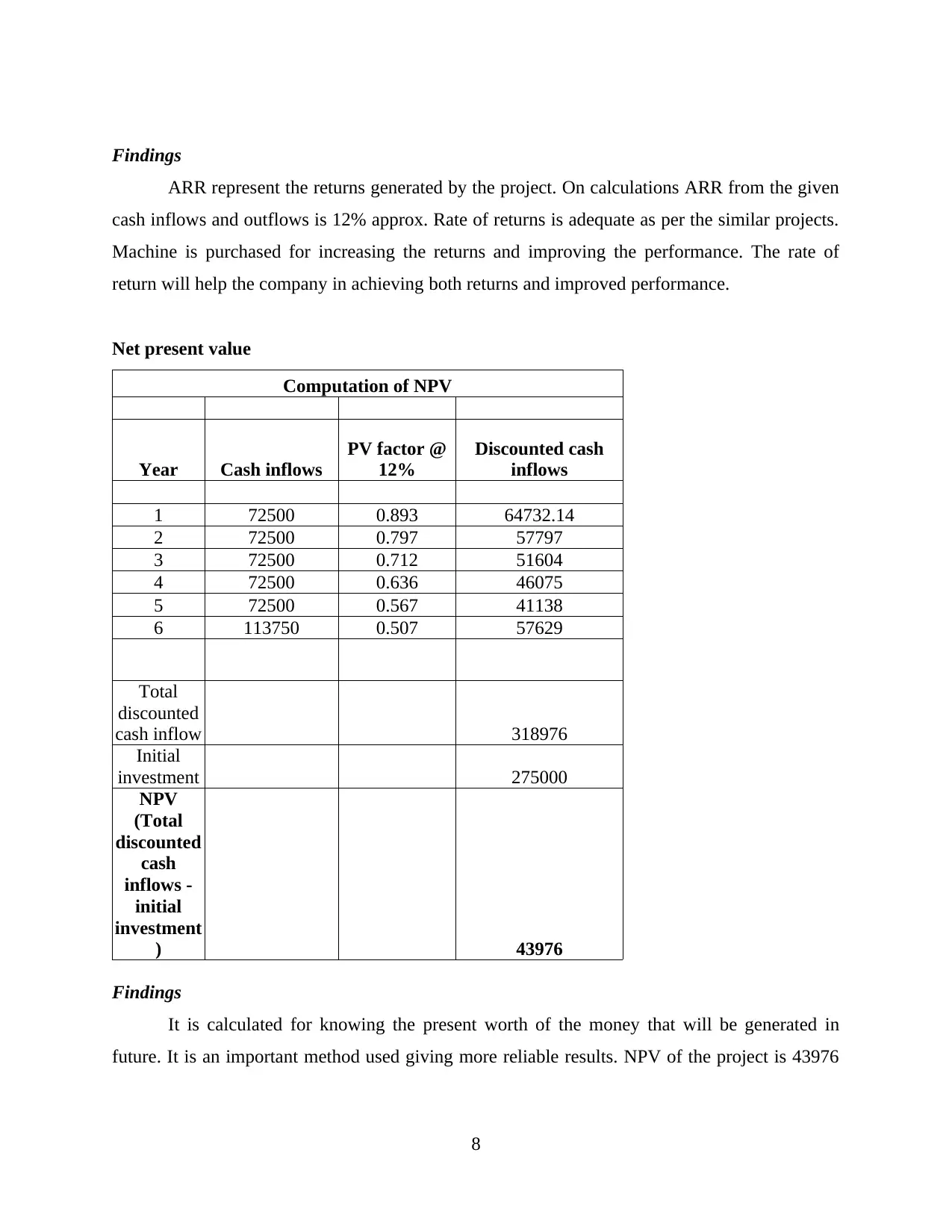
Findings
ARR represent the returns generated by the project. On calculations ARR from the given
cash inflows and outflows is 12% approx. Rate of returns is adequate as per the similar projects.
Machine is purchased for increasing the returns and improving the performance. The rate of
return will help the company in achieving both returns and improved performance.
Net present value
Computation of NPV
Year Cash inflows
PV factor @
12%
Discounted cash
inflows
1 72500 0.893 64732.14
2 72500 0.797 57797
3 72500 0.712 51604
4 72500 0.636 46075
5 72500 0.567 41138
6 113750 0.507 57629
Total
discounted
cash inflow 318976
Initial
investment 275000
NPV
(Total
discounted
cash
inflows -
initial
investment
) 43976
Findings
It is calculated for knowing the present worth of the money that will be generated in
future. It is an important method used giving more reliable results. NPV of the project is 43976
8
ARR represent the returns generated by the project. On calculations ARR from the given
cash inflows and outflows is 12% approx. Rate of returns is adequate as per the similar projects.
Machine is purchased for increasing the returns and improving the performance. The rate of
return will help the company in achieving both returns and improved performance.
Net present value
Computation of NPV
Year Cash inflows
PV factor @
12%
Discounted cash
inflows
1 72500 0.893 64732.14
2 72500 0.797 57797
3 72500 0.712 51604
4 72500 0.636 46075
5 72500 0.567 41138
6 113750 0.507 57629
Total
discounted
cash inflow 318976
Initial
investment 275000
NPV
(Total
discounted
cash
inflows -
initial
investment
) 43976
Findings
It is calculated for knowing the present worth of the money that will be generated in
future. It is an important method used giving more reliable results. NPV of the project is 43976
8
Paraphrase This Document
Need a fresh take? Get an instant paraphrase of this document with our AI Paraphraser
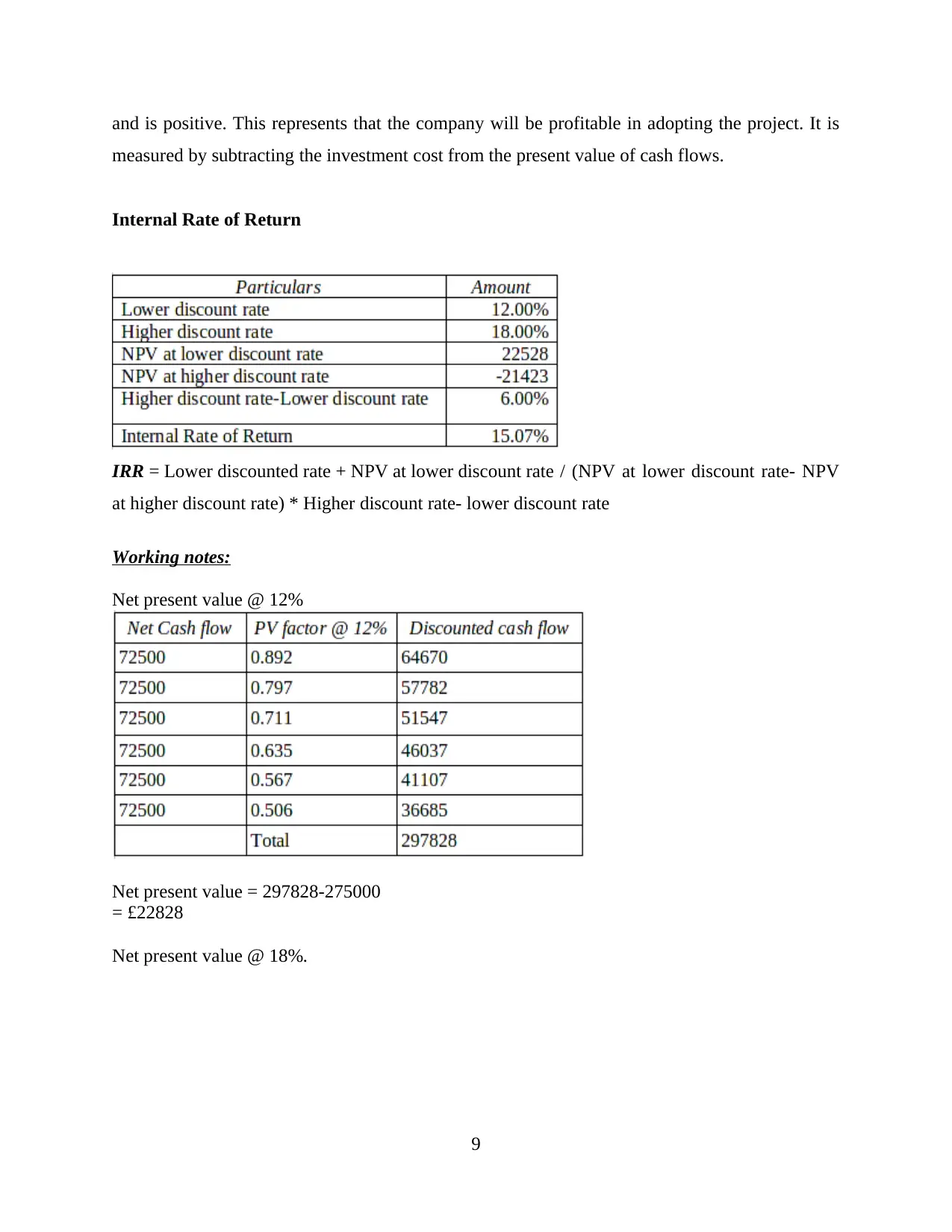
and is positive. This represents that the company will be profitable in adopting the project. It is
measured by subtracting the investment cost from the present value of cash flows.
Internal Rate of Return
IRR = Lower discounted rate + NPV at lower discount rate / (NPV at lower discount rate- NPV
at higher discount rate) * Higher discount rate- lower discount rate
Working notes:
Net present value @ 12%
Net present value = 297828-275000
= £22828
Net present value @ 18%.
9
measured by subtracting the investment cost from the present value of cash flows.
Internal Rate of Return
IRR = Lower discounted rate + NPV at lower discount rate / (NPV at lower discount rate- NPV
at higher discount rate) * Higher discount rate- lower discount rate
Working notes:
Net present value @ 12%
Net present value = 297828-275000
= £22828
Net present value @ 18%.
9
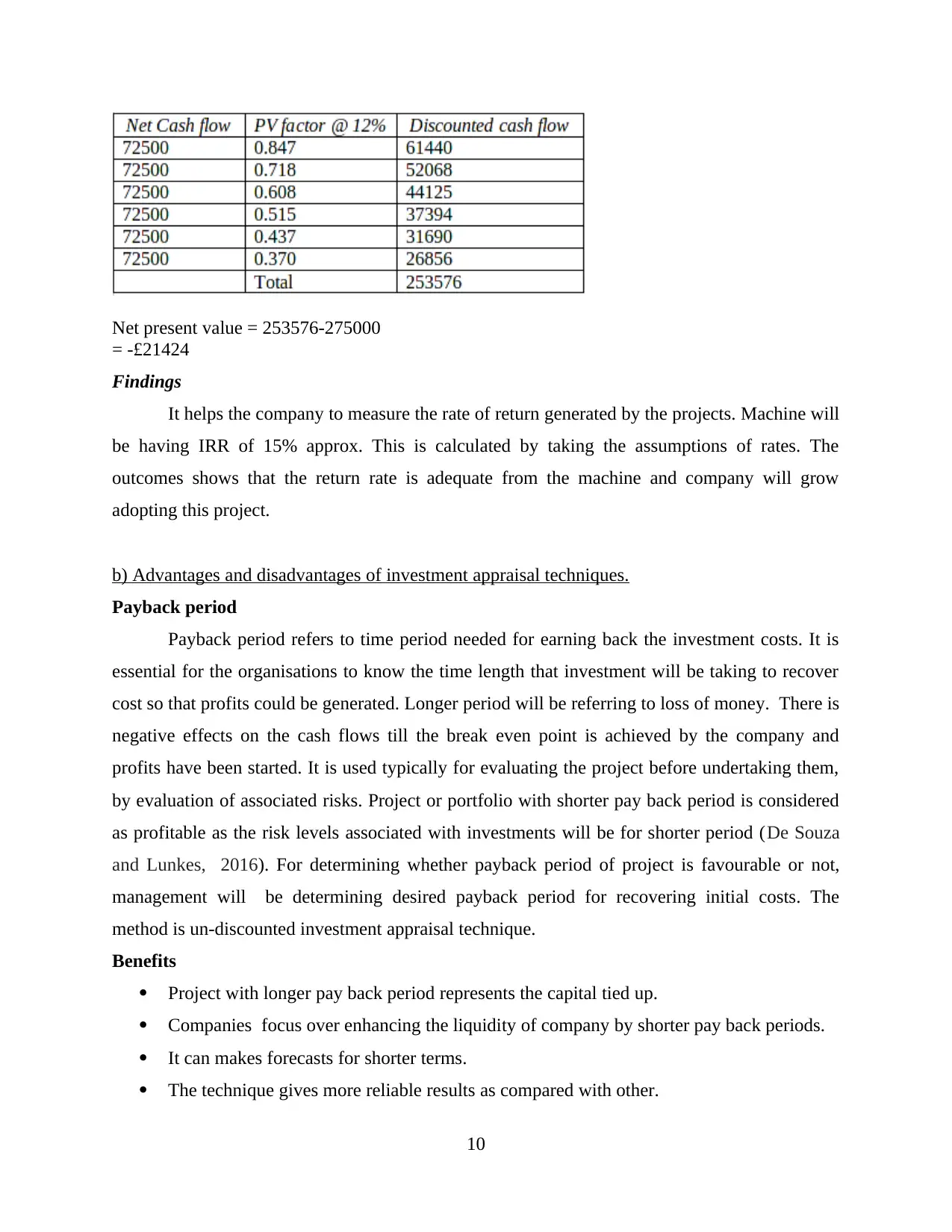
Net present value = 253576-275000
= -£21424
Findings
It helps the company to measure the rate of return generated by the projects. Machine will
be having IRR of 15% approx. This is calculated by taking the assumptions of rates. The
outcomes shows that the return rate is adequate from the machine and company will grow
adopting this project.
b) Advantages and disadvantages of investment appraisal techniques.
Payback period
Payback period refers to time period needed for earning back the investment costs. It is
essential for the organisations to know the time length that investment will be taking to recover
cost so that profits could be generated. Longer period will be referring to loss of money. There is
negative effects on the cash flows till the break even point is achieved by the company and
profits have been started. It is used typically for evaluating the project before undertaking them,
by evaluation of associated risks. Project or portfolio with shorter pay back period is considered
as profitable as the risk levels associated with investments will be for shorter period (De Souza
and Lunkes, 2016). For determining whether payback period of project is favourable or not,
management will be determining desired payback period for recovering initial costs. The
method is un-discounted investment appraisal technique.
Benefits
Project with longer pay back period represents the capital tied up.
Companies focus over enhancing the liquidity of company by shorter pay back periods.
It can makes forecasts for shorter terms.
The technique gives more reliable results as compared with other.
10
= -£21424
Findings
It helps the company to measure the rate of return generated by the projects. Machine will
be having IRR of 15% approx. This is calculated by taking the assumptions of rates. The
outcomes shows that the return rate is adequate from the machine and company will grow
adopting this project.
b) Advantages and disadvantages of investment appraisal techniques.
Payback period
Payback period refers to time period needed for earning back the investment costs. It is
essential for the organisations to know the time length that investment will be taking to recover
cost so that profits could be generated. Longer period will be referring to loss of money. There is
negative effects on the cash flows till the break even point is achieved by the company and
profits have been started. It is used typically for evaluating the project before undertaking them,
by evaluation of associated risks. Project or portfolio with shorter pay back period is considered
as profitable as the risk levels associated with investments will be for shorter period (De Souza
and Lunkes, 2016). For determining whether payback period of project is favourable or not,
management will be determining desired payback period for recovering initial costs. The
method is un-discounted investment appraisal technique.
Benefits
Project with longer pay back period represents the capital tied up.
Companies focus over enhancing the liquidity of company by shorter pay back periods.
It can makes forecasts for shorter terms.
The technique gives more reliable results as compared with other.
10
⊘ This is a preview!⊘
Do you want full access?
Subscribe today to unlock all pages.

Trusted by 1+ million students worldwide
1 out of 17
Related Documents
Your All-in-One AI-Powered Toolkit for Academic Success.
+13062052269
info@desklib.com
Available 24*7 on WhatsApp / Email
![[object Object]](/_next/static/media/star-bottom.7253800d.svg)
Unlock your academic potential
Copyright © 2020–2025 A2Z Services. All Rights Reserved. Developed and managed by ZUCOL.





